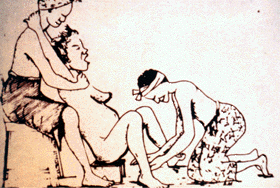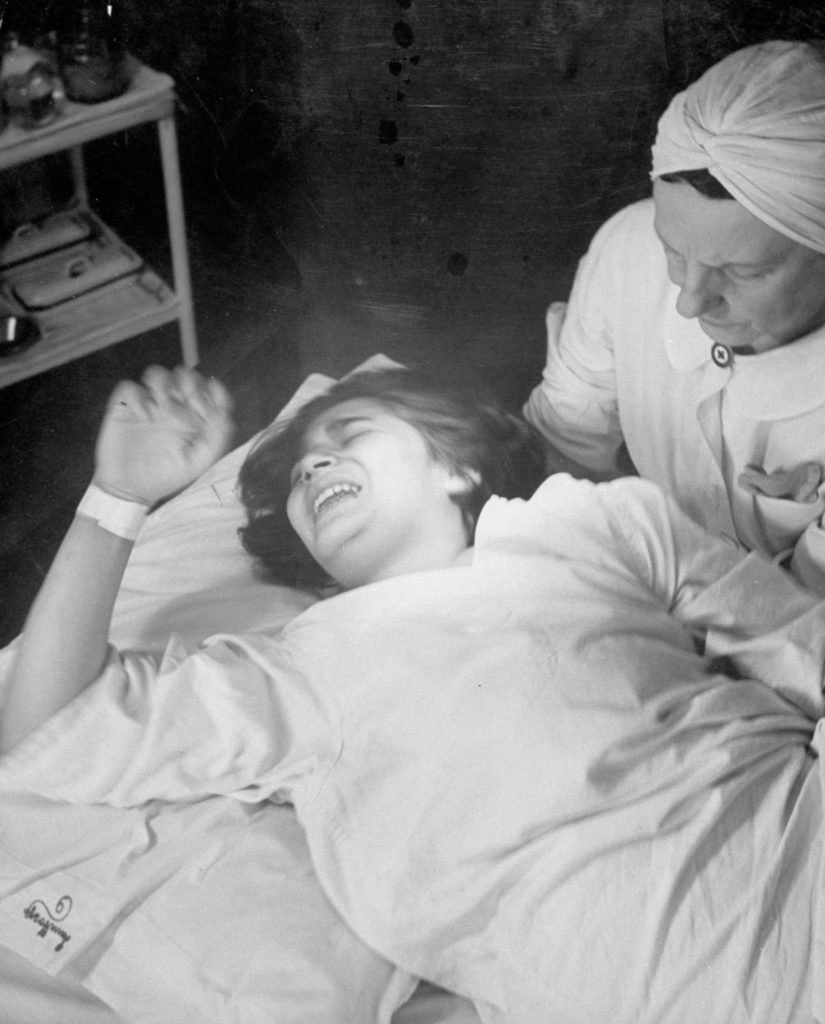When Read looked into the state of maternity care in the early twentieth century in Britain, he found high rates of maternal and infant mortality as well as morbidities for both mother and child. This issue was also recognized by the British government. According to Lewis, “During World War I,it was realized that foetal and neonatal deaths were associated with the mother’s welfare, and the overwhelming desire to increase population caused infant welfare work to be extended to the ante-natal period.”[1] The need to repopulate Europe after the decimation of the population of Europe because of World War I, gave rise to a governmental push to procreate. Adding in to this mix, the end of World War I brought the end to the age of colonization.The great European explorers brought back new anthropological information about “savage” societies in the name of scientific study.
One notable example is George Englemann’s ethnographic survey of birthing practices throughout the Americas and Africa, entitled Labor Among Primitive Peoples: Showing the Development of the Obstetric Science of To-day, from the Natural and Instinctive Customs of All Races, Civilized and Savage, Past and Present (1882); a clear example of the notion of the noble savage. The book is rife with language and images describing tribal people’s methods of birthing babies with a subtle emphasis on how these primitive uncivilized people give birth more easily and, in less pain, than do their civilized white European and American counterparts.

Read would have likely known about Englemann’s work, given his previous status as a founding member of the American Gynecological Society in 1876 and president in 1900, in addition to being an honorary member of many obstetric societies both in America and Europe.[2] The influence of the idea of the noble savage and its converse, the overcivilized woman is prevalent in Read’s writings.[3] Briggs defines “overcivilization” as; “hysterical illness was the provenance almost exclusively of Anglo-American, native born whites, specifically white women of a certain class.”[4]
Newell, writing in 1908, believed there was an abnormal type of labor happening among overcivilized women, which was causing their demise and that of their babies,thus leaving society with less desirable offspring from less desirable mothers.[5] The symptoms therein being “prolapsed uterus,diseased ovaries, long and difficult childbirths – maladies that made it difficult for these hysterical (white) women to have children.”[6] These overcivilized women were Read’s target market for his method.
Read not only subscribed to this belief in the overcivilized woman and the noble savage but he also believed that there needed to be a return to a more natural way of giving birth and that modern society and its medical interventions, in many cases, caused more harm than good. Read believed that a return to natural childbirth would bring about not only a return to more natural order, but through his idea of “motherlove” also bring about peace on earth. According to Read, natural childbirth is a return to God’s plan for humanity.These concepts colored his writings and provide a foundation for his revelation of natural childbirth to be rooted in conventional societal beliefs.
Concurrent with Read’s work, The National Health in the UK was created specifically to combat the issues of maternal mortality and bring a greater focus on infant mortality. Through the National Conference on Infant Mortality, it was decided that maternal education held the solution.[7] Lewis also notes that working class mothers were “consigned to the vicissitudes of both the feeding bottle and the childminder.”[8]
Working class women needed to be better mothers by emulating their middle class counter parts through education, birth and motherhood thus improving their race. Read was swimming in this miasma of eugenics and religion and it is very clearly seen in his book.
Moreover, a new “twilight sleep” anesthesia had hit the market in 1914 and was sold to women as painless birth, with the true intention to bring women out of the home and into the hospital for birth as part of the legitimization of the profession of obstetrics.[9] The challenge being that twilight sleep was a scopolamine – morphine combination that provided mild pain relief and a hallucinogenic, which provided an amnesiac effect, such that women could not remember their births.[10]

Read, being familiar with the administration of these medications as well as being familiar with homebirth, since he attended births both in hospital and out,decided that something critical was lost for women with the loss of the birthing experience. This he attributed in his revelation where returning to a more natural, less medically interventive order would be humanity’s saving, and he, the prophet, would be its savior.
Read was a man of no small ego. When reading his biography, Dr. Courageous (1957), it is apparent that the writing style is suspiciously similar to that of Childbirth without Fear, Read’s own book. It is suspected, and I agree, that Read had heavy influence with the author and possibly wrote certain passages himself. His biography/autobiography reads like an origin story for any strong religious figure be that Buddha, Jesus, Moses or Mohammed. He lists his credentials like the begets in the bible, to prove his lineage and his worth. He speaks and acts like a prophet, tells stories of miracles (i.e. the testimonials from mothers), offers strong dogmatic defense of his faith and uses his priesthood of believers (the mothers) to share the information which was given to him as a direct revelation from God to make a new peace on earth.His method and his writings are the only way to salvation.
This sets the tone for his becoming a prophet and a savior not only of women and childbirth but of humanity as a whole. In such a manner, Read begins to segregate himself from his medical colleagues setting himself up to become a deviant in the medical community.
Next up: Martyrdom – But Through Faith Alone… Where’s the Evidence?
[1] Lewis, J. (1980), The politics of motherhood, child and maternal welfare in England, 1900-1939, p.33
[2] Dunn, P.M. (1995), Dr. George Englemann of St. Louis (1847-1903) and the ethnology of childbirth. p. 145
[3] Read, G.D. (1942), Childbirth without Fear, p. 20-21
[4] Briggs, L. (2000), The race of hysteria: “Overcivilization” and the “savage” woman in late nineteenth-century obstetrics and gynecology, p. 246
[5] Newell, F. S., (1908), The effects of overcivilization on maternity, p. 533
[6] Ibid, p. 534
[7] Lewis, J. (1980), The politics of motherhood, child and maternal welfare in England, 1900-1939, p.61
[8] ibid
[9] Wolf, J. H. (2009), Deliver me from Pain, Anesthesia and Birth in America, p. 61 – 63
[10] Sandelowski, M. (1984), Pain, Pleasure and American Childbirth, from Twilight Sleep to the Read Method 1914-1960, p. 13
Become a Patron!
Leave a Reply